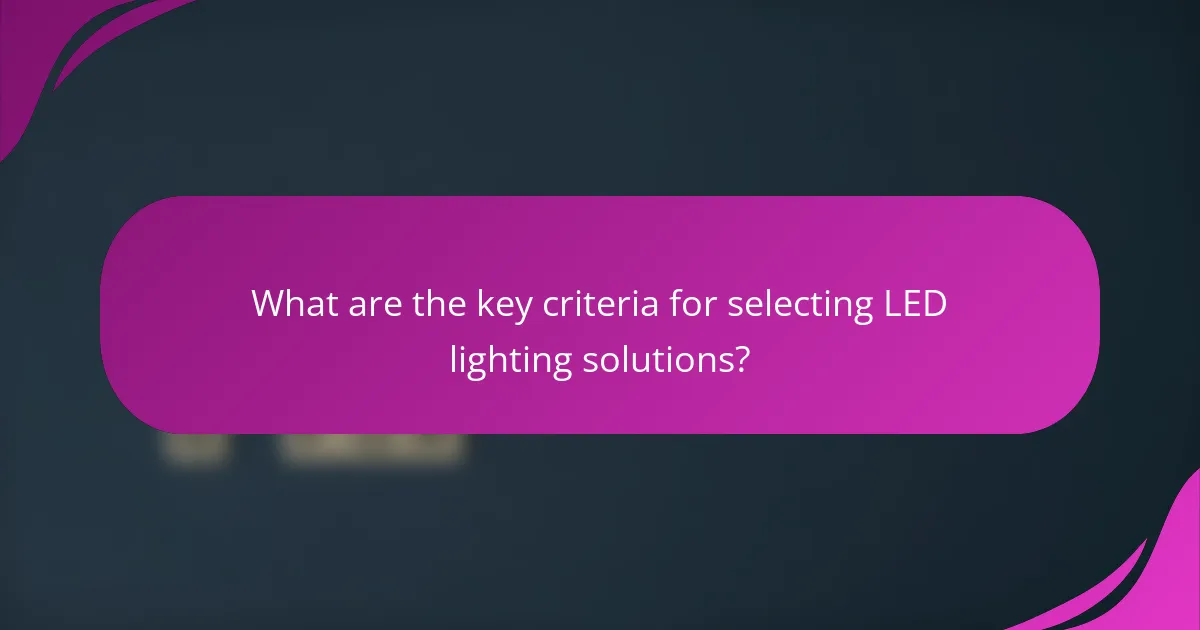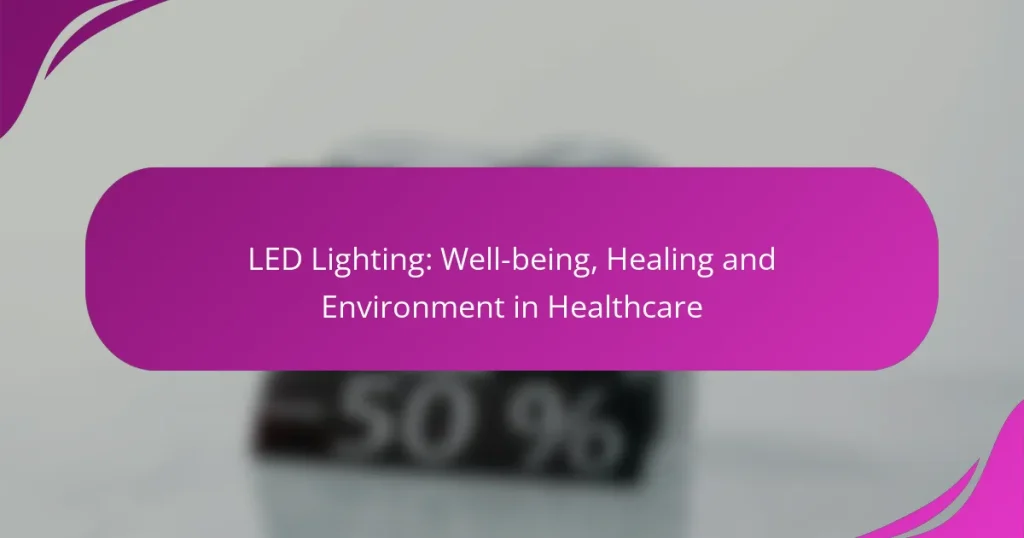LED lighting plays a crucial role in enhancing well-being and healing in healthcare environments by promoting comfort and reducing stress for patients. With adjustable color temperatures and brightness, these lights can positively influence mood and support recovery processes. Additionally, LED technology contributes to environmental sustainability by lowering energy consumption and minimizing waste in healthcare facilities.

How does LED lighting improve well-being in healthcare?
LED lighting enhances well-being in healthcare by creating environments that promote comfort, reduce stress, and support healing. Its adjustable color temperatures and brightness levels can significantly influence patients’ moods and overall mental health.
Enhanced mood and mental health
LED lighting can positively impact mood and mental health by mimicking natural light, which helps regulate circadian rhythms. In healthcare settings, using warmer color temperatures during the evening can create a calming atmosphere, while cooler temperatures during the day can enhance alertness.
For example, hospitals that incorporate LED lighting with adjustable settings report improved patient satisfaction and a more positive environment. This can lead to quicker recovery times and a better overall experience for both patients and staff.
Reduced stress and anxiety
LED lighting can effectively reduce stress and anxiety levels in healthcare environments. Soft, warm lighting can create a soothing atmosphere, which is particularly beneficial in areas such as waiting rooms and patient recovery areas.
Implementing dimmable LED lights allows healthcare facilities to adjust the lighting based on the time of day or specific patient needs, helping to create a more relaxed environment. This flexibility can significantly contribute to lowering anxiety levels among patients and visitors.
Improved sleep quality
LED lighting plays a crucial role in improving sleep quality for patients in healthcare settings. By using cooler, blue-enriched light during the day and warmer tones at night, facilities can help regulate patients’ sleep-wake cycles.
Healthcare providers should consider implementing lighting strategies that align with patients’ natural rhythms. For instance, reducing bright light exposure in the evening can promote better sleep, leading to enhanced recovery and overall well-being.

What are the healing benefits of LED lighting in hospitals?
LED lighting in hospitals offers significant healing benefits by promoting faster recovery and enhancing patient well-being. These lights can improve mood, reduce stress, and facilitate various healing processes, making them an essential component of modern healthcare environments.
Accelerated wound healing
LED lighting can accelerate wound healing by stimulating cellular activity and promoting tissue regeneration. The specific wavelengths emitted by LED lights, particularly in the red and near-infrared spectrum, have been shown to enhance blood circulation and collagen production, which are crucial for healing.
Hospitals utilizing LED lighting in treatment areas often report quicker recovery times for patients with surgical wounds or injuries. For example, studies suggest that patients exposed to LED light therapy may experience healing times that are significantly shorter than those under conventional lighting.
Enhanced patient recovery times
Patients recovering in environments with LED lighting often experience enhanced recovery times due to improved mood and reduced anxiety levels. The calming effects of specific light wavelengths can lead to better sleep quality, which is vital for healing.
Moreover, LED lighting can be adjusted to mimic natural daylight, helping to regulate circadian rhythms. This adjustment can result in patients feeling more alert during the day and more relaxed at night, ultimately supporting a faster recovery process.

How does LED lighting impact the environment in UK healthcare facilities?
LED lighting significantly benefits the environment in UK healthcare facilities by reducing energy consumption and minimizing waste. These lights have a longer lifespan and lower carbon emissions compared to traditional lighting, making them a sustainable choice for healthcare settings.
Energy efficiency and cost savings
LED lights are highly energy-efficient, consuming up to 80% less electricity than incandescent bulbs. This efficiency translates into substantial cost savings on energy bills, which can be particularly beneficial for healthcare facilities that operate 24/7.
For example, switching to LED lighting can reduce annual lighting costs by several thousand pounds, depending on the size of the facility. Additionally, the longer lifespan of LEDs, often exceeding 25,000 hours, means fewer replacements and lower maintenance costs.
Reduction of carbon footprint
By using LED lighting, healthcare facilities can significantly lower their carbon footprint. The reduced energy consumption leads to fewer greenhouse gas emissions, contributing to a cleaner environment.
In the UK, where the National Health Service (NHS) aims to achieve net-zero carbon emissions by 2040, adopting LED lighting is a crucial step. Facilities can actively participate in this initiative by replacing outdated lighting systems with energy-efficient alternatives, thereby supporting broader environmental goals.

What are the best practices for implementing LED lighting in healthcare?
Implementing LED lighting in healthcare requires careful consideration of color temperature, placement, and design to enhance patient well-being and support healing. Best practices focus on creating a balanced environment that promotes comfort and efficiency while adhering to safety standards.
Choosing the right color temperature
The color temperature of LED lighting significantly impacts mood and perception in healthcare settings. Generally, a range of 3000K to 5000K is recommended, with warmer tones (around 3000K) being suitable for patient rooms to promote relaxation, while cooler tones (around 4000K to 5000K) are ideal for work areas to enhance alertness.
Consider the specific needs of each area; for example, surgical rooms may benefit from cooler, brighter light to improve visibility, while waiting areas should utilize warmer light to create a calming atmosphere. Always ensure that the chosen color temperature aligns with the overall design and purpose of the space.
Optimal placement and design considerations
Effective placement of LED lighting is crucial for maximizing its benefits in healthcare environments. Lights should be positioned to minimize shadows and glare, particularly in examination and treatment areas. Overhead lighting combined with task lighting can provide the necessary illumination for various activities.
Design considerations should include the use of dimmable fixtures to adjust light levels according to the time of day and specific tasks. Incorporating natural light where possible can also enhance the healing environment, as studies show that exposure to daylight can improve patient outcomes. Regularly assess lighting effectiveness and make adjustments based on feedback from staff and patients.

What are the key criteria for selecting LED lighting solutions?
When selecting LED lighting solutions for healthcare environments, consider factors such as compliance with health regulations, energy efficiency, and compatibility with existing systems. These criteria ensure that the lighting not only meets operational needs but also supports patient well-being and safety.
Compliance with health regulations
Compliance with health regulations is crucial when choosing LED lighting solutions for healthcare settings. Standards such as the International Electrotechnical Commission (IEC) and the American National Standards Institute (ANSI) provide guidelines on safety and performance. Ensuring that your lighting meets these regulations can prevent legal issues and enhance patient safety.
Additionally, consider local regulations that may dictate specific lighting requirements, such as color temperature and intensity levels. For instance, some jurisdictions may recommend warmer light for patient areas to promote relaxation, while cooler light may be preferred in surgical settings for better visibility.
Compatibility with existing systems
Compatibility with existing systems is essential for a smooth transition to LED lighting. Assess the current infrastructure, including wiring and control systems, to determine if modifications are necessary. Using LED fixtures that can integrate with existing dimming systems or smart controls can save time and reduce costs.
When evaluating compatibility, consider the types of fixtures already in use. For example, retrofitting existing fixtures with LED bulbs can be a cost-effective solution, while complete replacements may be warranted in older facilities. Always consult with a lighting specialist to ensure proper integration and optimal performance.

What are the cost implications of LED lighting in healthcare?
LED lighting in healthcare can lead to significant cost savings over time, despite a higher initial investment. The long-term benefits include reduced energy consumption and lower maintenance costs, making it a financially sound choice for healthcare facilities.
Initial investment vs. long-term savings
The initial investment for LED lighting can be higher than traditional lighting options, often ranging from 20% to 50% more. However, healthcare facilities can expect substantial long-term savings due to lower energy bills and longer lifespan of LED fixtures.
For example, switching to LED lighting can reduce energy consumption by about 50% to 70%, translating to thousands of dollars saved annually, depending on the facility size and usage. This makes the upfront costs more justifiable over time.
Maintenance costs and lifespan
LED lights typically have a lifespan of 25,000 to 50,000 hours, significantly outlasting traditional bulbs, which may last only 1,000 to 2,000 hours. This extended lifespan reduces the frequency of replacements and associated labor costs.
Maintenance costs for LED lighting are generally lower due to their durability and reliability. Facilities can save on both replacement expenses and the labor required for maintenance, allowing staff to focus on patient care rather than lighting issues.

How does LED lighting compare to traditional lighting in healthcare?
LED lighting offers significant advantages over traditional lighting in healthcare settings, particularly in energy efficiency and patient comfort. By providing better illumination while consuming less power, LEDs contribute to both operational savings and improved well-being for patients and staff.
Energy consumption differences
LED lighting typically consumes about 75% less energy than incandescent bulbs and around 50% less than fluorescent lights. This reduction in energy use translates to lower electricity bills, which can be substantial in large healthcare facilities. Additionally, LEDs have a longer lifespan, often lasting up to 25,000 hours or more, reducing the frequency and cost of replacements.
Healthcare facilities can benefit from energy-efficient lighting by investing in LED technology, which aligns with sustainability goals and can help meet regulatory standards for energy consumption. Many hospitals are now incorporating LED systems to enhance their green initiatives.
Impact on patient outcomes
Research indicates that LED lighting can positively influence patient outcomes by enhancing mood and reducing stress. The quality of light affects circadian rhythms, which are crucial for recovery and overall health. Properly designed LED lighting can mimic natural light patterns, aiding in the healing process.
Moreover, the ability to adjust the color temperature of LED lights allows healthcare providers to create environments that are more conducive to relaxation or alertness, depending on the time of day. This adaptability can lead to shorter hospital stays and improved patient satisfaction.


